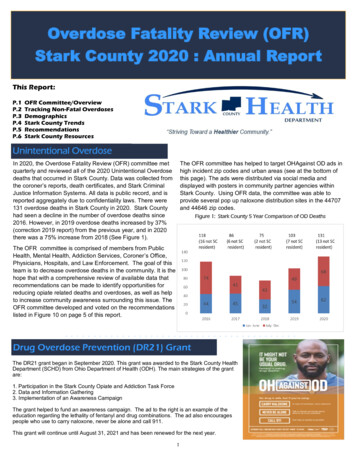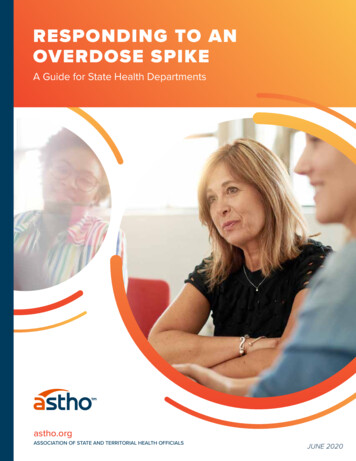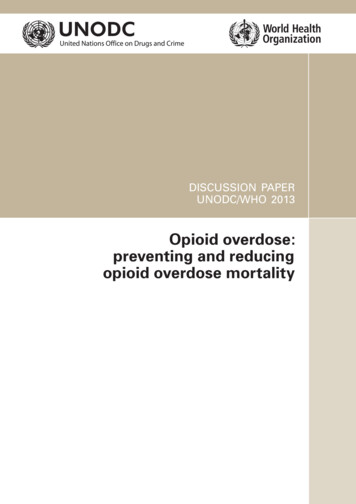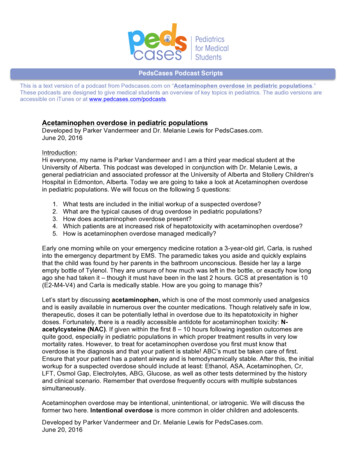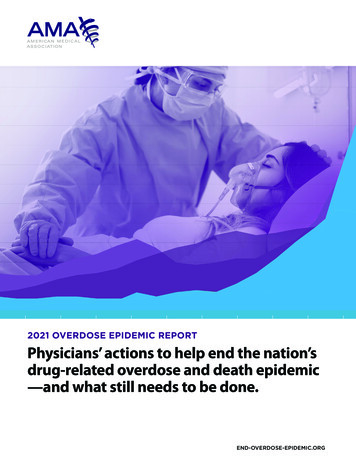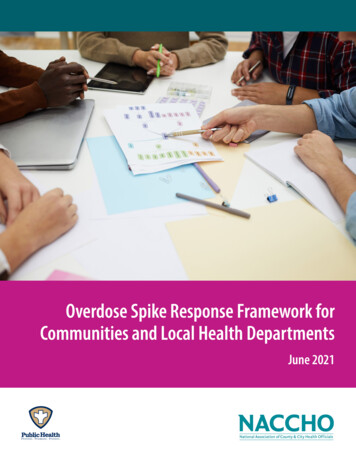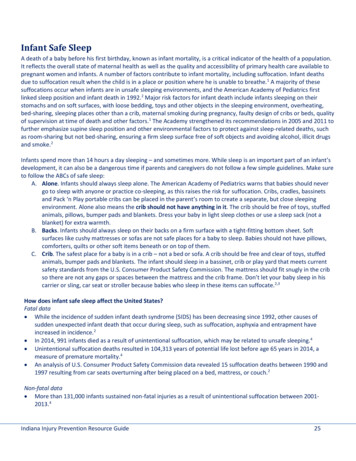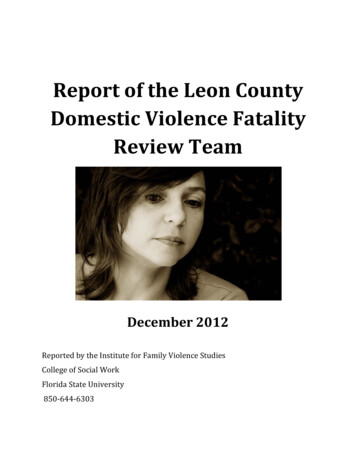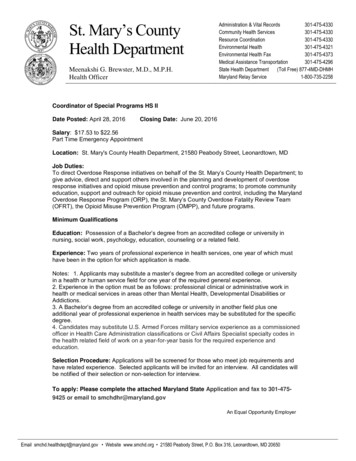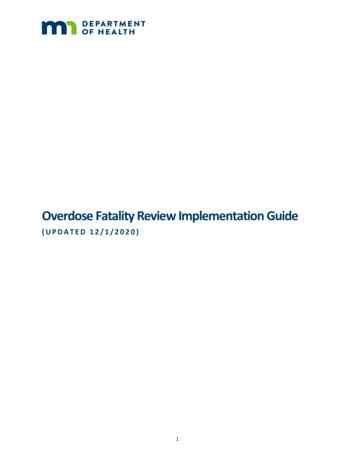
Transcription
Overdose Fatality Review Implementation Guide(UPDATED 12/1/2020)1
OVERDOSE FATALITY REVIEW IMPLEMENTATION GUIDETable of ContentsOverdose Fatality Review Implementation Guide . 1Introduction . 4What Is the Overdose Epidemic? . 4Are Overdose Deaths Preventable? . 4What Is an OFR? . 4Why Are OFRs a Useful Strategy for Preventing Overdose Deaths? . 5OFR Guide Acknowledgement . 5Thank You! . 5Contact MDH about OFR Teams . 5Module 1: Developing an OFR Team . 6What is an OFR team?. 6OFR Structure and Roles . 9Module 2: Planning an OFR Meeting . 15Meeting Logistics . 15Meeting Preparation: Coordinator’s Activities . 16Meeting Preparation: Member Activities . 19Module 3: Facilitating an OFR Meeting . 22Facilitator’s Role. 22OFR Meeting Agenda . 22Meeting Facilitation Strategies . 25Managing Difficult Conversations . 27Measuring Meeting Success . 29Preventing Case Review Burnout. 30Module 4: Collect Your OFR Data . 32Confidentiality . 32Data Collection Process . 34Minnesota Overdose Fatality Review REDCap Database . 34Module 5: Build a Recommendation Plan . 35Identifying Recommendations During the OFR Review . 35Documenting Recommendations . 352
OVERDOSE FATALITY REVIEW IMPLEMENTATION GUIDEForming a Subcommittee to Develop Recommendations. 36Implementing a Recommendation . 38Overdose Fatality Review Online Resources . 40Module 1: Developing an OFR Team Appendix . 41Sample OFR Recruitment Letter . 41Sample Interagency Data Sharing Agreement . 42Module 2: Planning an OFR Meeting Appendix . 44Agency Specific Data Elements . 44OFR Coordinator’s Meeting Preparation Checklist . 45OFR Case Email. 46Sample Meeting Agenda . 47Team Member Guide to Collecting Case Information . 48Template for Creating and Presenting a Case Summary . 49Module 3: Facilitating an OFR Meeting Appendix . 50Sample Confidentiality Agreement . 50Sample Summary Data Report . 51Sample Governing Committee Report Out . 51Sample Meeting Ground Rules . 52Meeting Minutes Template . 53Module 4: Collect Your OFR Data Appendix . 54Example Commitment to Data Privacy . 54Sample Data Sharing Protocol . 56Module 5 Appendix: Build a Recommendation Plan Appendix . 57Table of Recommendation Types . 57Sample Recommendation Work Plan . 583
OVERDOSE FATALITY REVIEW IMPLEMENTATION GUIDEIntroductionThis Overdose Fatality Review (OFR) Implementation Guide is designed to provide an overviewof what OFRs entail, how to facilitate OFRs, and managing an OFR team. This guide is specific toOFR teams working in Minnesota. OFRs are an impactful prevention activity that readers of thisguide will hopefully feel confident leading in their communities to reduce overdose deaths.What Is the Overdose Epidemic?Drug overdoses are a leading cause of death in the United States. From 1999 to 2017, morethan 702,000 people died from a drug overdose in America; 67,000 died in 2018. In 2019, 761Minnesotans died from a preventable drug overdose – a 20% increase from 2018, and acontinued trend seen since 2000. There are significant differences in rates of drug overdosedeath among Minnesotans by race. In 2019, an African American resident was almost two timesas likely, and an American Indian resident was seven times more likely, to die from drugoverdose than a white resident in Minnesota.Are Overdose Deaths Preventable?Yes. Overdose deaths can be prevented with coordinated prevention strategies, timelyimplementation of evidence based interventions, community mobilization, and supportivefamilies and friends. The shared understanding that overdose deaths are preventable guidesthe entire OFR process.What Is an OFR?The purpose of an OFR is to effectively identify system gaps and innovative community-specificoverdose prevention and intervention strategies. In practice, OFRs involve a series ofconfidential individual death reviews by a multidisciplinary team. A death review (also referredto as a “case review”) examines the life of a person who died of an overdose in terms of druguse history, comorbidity, major health events, social-emotional trauma (including adversechildhood experiences), encounters with law enforcement and the criminal justice system,treatment history, and other factors, including local conditions (high school graduation, foodsecurity, income, etc.) to facilitate a deeper understanding of the missed opportunities forprevention and intervention that may have prevented an overdose death.By conducting a series of OFRs, communities begin to see patterns of need and opportunity, notonly within specific agencies but across systems. Blending input from public health, publicsafety, healthcare providers, and the community, OFR teams develop program and policyrecommendations to improve coordination and collaboration between agencies andcommunity conditions to prevent future overdose deaths. Examples of successfulrecommendations include the integration of peer recovery specialists into new settings,targeted naloxone distribution, and improved coordination of public safety and public health.4
OVERDOSE FATALITY REVIEW IMPLEMENTATION GUIDEWhy Are OFRs a Useful Strategy for Preventing Overdose Deaths?Fatality reviews are used to address several complex public health issues. Reviews such ashomicide, child death, maternal mortality, critical incidents, suicide, and overdose deaths sharemany common components such as a focus on prevention, convening of multidisciplinaryteams to do a series of case reviews, identification of missed opportunities for prevention andintervention, and development and implementation of data-driven prevention and interventionstrategies. The OFR process generates information about the decedent and their interactionswith services and systems. This information is used to craft recommendations to prevent futuresimilar deaths.OFR Guide AcknowledgementThe Minnesota Department of Health (MDH) would like to thank the Institute forIntergovernmental Research (IIR) for developing the Overdose Fatality Review Practitioner’sGuide from which this guidance is adapted.Thank You!MDH thanks you for your work implementing OFRs across the state. The work done by yourOFR Team contributes to the statewide effort to improve our systems that serve Minnesotanswith substance use disorder.Contact MDH about OFR TeamsTo contact the MDH Injury and Violence Prevention Section’s OFR subject matter experts,please send an email to health.drugodprev@state.mn.us.To find the most recent statewide drug overdose and substance use data, please visit the MDHOverdose Dashboard online. Other Minnesota-specific online resources are listed in OverdoseFatality Review Online Resources.5
OVERDOSE FATALITY REVIEW IMPLEMENTATION GUIDEModule 1: Developing an OFR TeamWhat is an OFR team?OFR teams are multidisciplinary and include individuals who can share information about adecedent or contribute to the analysis of available data to make recommendations that willprevent future overdose deaths. Overdoses affect a variety of populations, neighborhoods, andcommunities. To effectively function and work toward the goal of preventing overdose deaths,OFR teams need a diverse set of members from disciplines and sectors that represent thecommunity.OFR team members are dedicated professionals who believe that overdoses are preventable,who are well-regarded in the field, and have time to attend regular meetings and participate infollow-up activities. Effective OFR teams have at least 10 members. More important than thenumber of team members is representation from all necessary fields and perspectives,including people from the same racial and ethnic community as the decedent. A list of potentialOFR team members is available below. Depending on the community, there might be otherservice providers and professionals that could be members of an OFR team that are notincluded on this list.Potential OFR Team Members: Local health department official Local law enforcement representative Medical examiner/coroner Prosecutor Local human services department official Substance use treatment provider Culturally specific substance use treatment provider or peer recovery specialist Medication-assisted treatment provider (MAT) Mental health social worker Pain management clinician Emergency department physician Primary care provider Pharmacist/toxicologist High Intensity Drug Trafficking Area (HIDTA) public health analyst Sheriff Probation and parole office Emergency medical service provider Drug treatment court representative Patient advocate Child protective services representative Substance use prevention professional School counselor Tribal elder, traditional leader6
OVERDOSE FATALITY REVIEW IMPLEMENTATION GUIDE Community leaderHousing authority representativeHarm reduction outreach professionalFinding the appropriate partner agencies and professionals to become OFR team members isessential in establishing an effective OFR. It is important to partner with agencies willing to: Provide quality services. Develop successful partnerships. Maintain consistent engagement. Be good stewards of data—following confidentiality. Engage in public policy or advocacy.Each partner agency should identify staff members (frontline staff, mid-level supervisors, orexecutives) who have the most appropriate roles within in the agency to be OFR team membersand who regularly attend and contribute to the OFR. All staffing levels are important andneeded on a review team to ensure the most complete understanding of how agencies andsystems work together, including what gaps exist and what steps may be needed to implementidentified prevention recommendations. This level of engagement ensures that at least oneperson from each agency can be present at each meeting and helps build internal agencyrelationships and champions for change. OFR team members are dedicated professionals whobelieve that overdoses are preventable, are well-regarded in the field, and have time to attendregular meetings and participate in follow-up activities.Some sectors, such as law enforcement agencies, may have more than one representative onOFR teams. For instance, if there are multiple law enforcement agencies (sheriff’s office, policedepartment, etc.) in the community, you may have both a sheriff’s office and a local lawenforcement representative. For some cases, OFR team members may have had previouscontact with a decedent or the decedent’s family or social network. They may also represent anagency that provided services to the decedent or where the decedent lived, or where theoverdose incident occurred. The OFR team members provide essential information about theconditions or environments in which the decedent was born, lived, worked, and aged and whatmay have contributed to the decedent’s overdose death.In addition to possibly providing services to the community and to the decedent, an effectiveOFR team member will also have: An understanding of the impact of the overdose epidemic in his or her community. The ability to assess problems at the macro or system level and assess organizationalpractices or communitywide initiatives. Authority to make decisions for the agency he or she represents or direct access todecision makers. The ability to critique work of other agencies and raise questions without passingjudgment.7
OVERDOSE FATALITY REVIEW IMPLEMENTATION GUIDEGuest MembersGiven the sensitive nature of the information shared and the need to build trustedrelationships, the OFR meetings are closed and not open to the public. Sometimes, invitedguests will participate or observe to learn more about OFRs. Most often, the invitedprofessionals have information specific to the case and are called guest members.An OFR meeting may focus on cases from a specific area in a geographic region where it wouldbe beneficial to invite nonprofit agencies, faith-based organizations, and other communityleadership or service agencies that are not consistent OFR team members. Guest members canprovide invaluable perspective, inform problem-solving discussion, and formulate realistic andcommunity-specific prevention recommendations. In addition, individuals that have directly orindirectly served an overdose decedent may have valuable information and may be invited toattend as guest members.Guest members representing agencies with information about the decedent may be identifiedfrom news coverage about the death or from medical examiner/coroner reports. Guestmembers could include elected officials, service providers not currently on the OFR team, orsomeone who wants to observe and learn more about the OFR process.Please keep in mind the size of an organization when reaching out to invite a guest memberand adjust expectations and hopes for their participation appropriately. Smaller communitybased organizations may take longer to respond or need more time to collect information priorto the OFR meeting than is usually provided. Participants from smaller nonprofit organizationsmay have limited time to prepare for reviews and limited staff capacity for meeting attendence.To support the inclusion of staff from smaller organizations, the coordinator could offer to helpa guest member write their case summary through a phone call or individual meeting, developa set of questions for the guest member to answer that the coordinator can share with the OFRteam if the guest member cannot attend the OFR meeting, or let the guest member share theircase summary first if they cannot attend the entirety of the meeting.OFR Team AttendanceEncouraging OFR team members to attend each OFR is important as it helps to build rapportand builds trust within the team. This trust allows for more open dialogue about each case andincreases commitment to recommendations. Missing even one meeting can impact the teamdynamics and members’ understanding of the overdose issues and prevention strategies. If amember cannot attend, they may send a pre-approved designee.Virtual OFRs:It is always an option to have both in-person and virtual components to an OFR meeting. Ingreater Minnesota, the time and expense to travel to attend an in-person meeting can be ahindrance to smaller organizations. The lead agency should consider if it would be a8
OVERDOSE FATALITY REVIEW IMPLEMENTATION GUIDErequirement for their OFR team that all members attend meetings in-person, attend at leastone meeting in-person every year, or if exclusively virtual attendance will be permitted.OFR Structure and RolesEvery OFR team should have a single lead coordinating agency that is guiding the work. The OFRlead agency oversees the OFR team by providing administrative support to fulfill three keyleadership roles: Facilitator Coordinator Data managerThe OFR team leadership structure and roles depend on the organization that has receivedfunding to complete OFRs. Organizations with significant financial and political support mayhave up to three separate funded staff positions. In other organizations, one person might havemultiple roles. The table below shows the tasks of each OFR leadership role and more detailedinformation on each role is available in the Facilitator, Coordinator, and Data Manager sections.Table 1. OFR Leadership Role TasksOFR Leadership RoleFacilitatorCoordinatorTasks Facilitate OFR meetings Recruit OFR team members Build and maintain relationships with OFR team members Orient new OFR team members Obtain and share case information with team members Review data and reports from team members Research information about cases that may not be provided byOFR members, such as reviewing social media, obituaries,media coverage, etc. Draft OFR meeting agendas, in partnership with the OFR teamfacilitator Manage meeting logistics (such as date and time, location, andtechnology support) Take minutes during each meeting Document activities since the last OFR meeting9
OVERDOSE FATALITY REVIEW IMPLEMENTATION GUIDEOFR Leadership RoleTasksData Manager Update the governing committee Support and communicate with subcommittees Enter case information and recommendations into OFRdatabase Write data or summary reports for sharing with the OFR teamand the governing committee Analyze OFR dataFacilitatorA representative from the organization funded by MDH should serve in the facilitation role. TheOFR team facilitator is responsible for activities such as: Facilitating OFR meetings Recruiting OFR team members Building and maintaining relationships with OFR team members Orienting new OFR team membersFacilitating OFR MeetingsOFR team meetings are facilitated using a problem-solving process to identifyrecommendations and to track and oversee implementation of developed recommendations.More information about the OFR team facilitation role is available in Module 3. Facilitate YourOFR Meeting.Recruiting Team MembersA key role for the lead agency and OFR leadership is recruiting and retaining team members.Members may need to be recruited and engaged before being requested to provide data,participate in a review, or assist with developing or implementing a recommendation. Theirperspectives and input will be valuable even if their organizations did not have direct contactwith the decedent or service area related to the case. For example, a drug treatment providerhas a valuable perspective on standards of care even if it did not provide services to the specificindividual being reviewed. A toxicologist or pharmacist may assist with understanding theprescription drugs provided to the decedent even if he or she did not interact with thatindividual.Effective recruitment is all in the details. Ideally, the OFR team facilitator will meet one-on-onewith new recruits to prepare members for what to expect when participating on a review teamby:10
OVERDOSE FATALITY REVIEW IMPLEMENTATION GUIDE Explaining the OFR goals and reviewing overall structure. Sharing stated and unstated group rules/norms. Emphasizing that the purpose of the meeting is not to point fingers at otherparticipants. Addressing any data sharing or confidentiality concerns and having them sign aconfidentiality agreement. Summarizing past and current recommendations relevant to their organization or areaof work. Suggesting immediate ways they can participate in developing and implementing arecommendation.Drafting an OFR recruitment email with the above information, a meeting schedule, and a clearlist of partner expectations will help communicate and recruit new active members. A sampleOFR recruitment letter is included in Module 1 Appendix.Before recruited members can participate on the review, they will need senior leadership tosign an interagency agreement. Review the sample interagency agreement in the Module 1Appendix for an example. Depending on whether your state has OFR-specific legislation,memoranda of understanding (MOUs) from data-providing members may be needed. Pleaserefer to the Module 4: Collect Your OFR Data section for more information specific toMinnesota.OFR teams benefit from ongoing recruitment of new members to address staff turnover,address gaps in their membership, or identify new trends. Periodically reviewing OFR teammember commitment, organizations represented, and recruiting new members in response tochanges in the community (i.e. new substance use treatment center or change in localsubstance use trends) can help to ensure that the OFR team is continuously responsive tocommunity need.Building and Maintaining RelationshipsBuilding and maintaining relationships can be achieved several ways. For example, the OFRteam can use meeting breaks as an opportunity to incorporate team building. This may involveas little as pulling aside a couple of participants and introducing them to each other andbringing up a shared interest or community connection. Encouraging members to stay after themeeting to network is another effective way to build trust and relationships.A more formal way to help build team cohesion is to provide general agency or memberupdates at the beginning or end of the meeting that may result in partnerships during andoutside of the fatality review experience. Keep in mind that if the relationship with the agencyis new, attending agency events and asking to observe the program may help you to get a sensefor what the agency does and will build rapport.11
OVERDOSE FATALITY REVIEW IMPLEMENTATION GUIDEOrienting New OFR Team MembersEvery team member will come to the table with different experiences, knowledge, prejudices,and ideas about substance use and its impact on his or her work and the community. It will bethe facilitator’s responsibility to lead meetings in a way that elevates all voices, addressesstigma or misinformation, and prioritizes a shared understanding. To prepare for this task, theteam facilitator may expect each member to obtain certain knowledge or training ahead ofparticipating in an OFR team meeting.Recommended trainings include the following: “Partnerships for Prevention: OFR 101” cuments/Events/coap ofr 101 jan 172020.pdf) “Overcoming Stigma, Ending Discrimination” ding/webcasts) “Why Addiction Is a ‘Disease’ and Why It’s ons-understanding/webcasts) “Social Determinants of Health: Know What Affects ndex.htm) “Words Matter: How Language Choices Can Reduce 5/session 101 ho3 words matter tot binder.pdf) Review table of recommendation types in Module 5 Appendix Review Minnesota Department of Health Opioids webpages, specifically socialdeterminants of substance use and overdose, race-rate disparity, and promisingprevention practicesSince death investigations vary by state, it may be beneficial for OFR team members to learnmore about the local death investigation process and the roles they play with informationavailable from the medical examiner’s/coroner’s office and local law enforcement agencies.Drug overdose death data come from Minnesota death certificates. After a death occurs, adeath investigation is completed, along with an autopsy (94% of drug overdose deaths had anautopsy completed in 2016), and a medical examiner or coroner makes a determination of thecause and manner of death. The cause of death information is then typed into thecorresponding sections of the death certificate. Once the medical examiner certifies andcompletes a death certificate, the information is then sent to the Office of Vital Records (OVR)at the Minnesota Department of Health (MDH).CoordinatorA representative from the lead agency should serve in the coordination role. The OFR teamcoordinator is responsible for activities such as:12
OVERDOSE FATALITY REVIEW IMPLEMENTATION GUIDE Obtaining and sharing case information with team members Receiving data and reports from team members Researching information about cases that may not be provided by OFR members, suchas reviewing social media, obituaries, media coverage, etc. Drafting OFR meeting agendas, in partnership with the OFR team facilitator Managing meeting logistics (such as date and time, location, and technology support) Taking minutes during each meeting Documenting activities since the last OFR meeting Updating the governing committee Supporting and communicating with subcommitteesMore information about the OFR team coordination role is available in Module 2. Planning anOFR Meeting.Data ManagerA representative from the lead agency should serve in the data manager role. On some OFRteams, the data manager role will be built into the coordinator or facilitator role depending onteam capacity. The OFR team data manager is primarily responsible for entering caseinformation and recommendations into the Minnesota Overdose Fatality Review REDCapdatabase. More information about the OFR data manager role is available in Module 4. CollectYour OFR Data and Module 5. Build a Recommendation Plan.In addition to entering data, there may be a need for analyzing data from other data sourcesand/or the OFR case data for OFR team meetings, governing committee updates, and annualreports. While the data manager tasks center around recording data, data analysis andfrequently reviewing data sources are the responsibility of all OFR team members. OFR teammembers benefit from staying up to date on new data and research.OFR SubcommitteesThe bulk of the work of an OFR may occur between meetings at the subcommittee level.Subcommittees may determine case selection criteria or how a recommendation may achieve apolicy change. For example, if an OFR identified improving care coordination among inpatientand outpatient treatment providers as a need, a subcommittee of local treatment providers,social workers, and patient advocates might convene to discuss gaps in care; identify partneragencies; and develop recommendations, an implementation plan, and a timeline forcompletion.Subcommittee membership may include members of the governing committee, the OFR team,and outside experts (e.g., experts related to addiction, homelessness, veterans’ affairs, orfamily survivors). Subcommittees meet separately from the OFR team and report to othermembers at case review meetings on their aims and prog
What Is the Overdose Epidemic? Drug overdoses are a leading cause of death in the United States. From 1999 to 2017, more than 702,000 people died from a drug overdose in America; 67,000 died in 2018. In 2019, 761 Minnesotans died from a preventable drug overdose - a 20% increase from 2018, and a continued trend seen since 2000.

